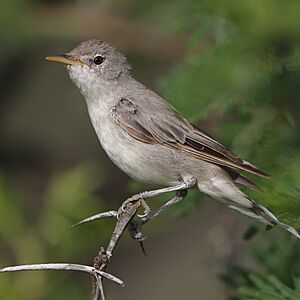Olive-tree warbler facts for kids
Quick facts for kids Olive-tree warbler |
|
|---|---|
 |
|
| In South Africa | |
| Conservation status | |
| Scientific classification | |
| Genus: |
Hippolais
|
| Species: |
olivetorum
|
 |
|
| Distribution of Olive-tree Warbler Summer resident (Breeding) Winter visitor | |
The olive-tree warbler (Hippolais olivetorum) is a small, migratory bird. It belongs to a group of birds called Old World warblers. This bird is the largest of the Hippolais warblers. It is known for its unique song and for traveling long distances.
Contents
Discover the Olive-Tree Warbler
Where Does It Live?
The olive-tree warbler breeds in southeast Europe and the Near East. This includes countries like Greece and Turkey. When winter arrives, these birds fly south. They spend the colder months in eastern and southern Africa. Their winter homes stretch from Kenya all the way down to South Africa.
What Kind of Home Does It Like?
This small passerine bird prefers certain types of habitats. You can find it in open oak woods. It also likes olive groves, orchards, and almond plantations. These places offer good cover and food sources.
What Does It Look Like?
The olive-tree warbler is a medium-sized bird. It is similar in size to the barred warbler. However, it has a slightly longer beak and a shorter tail. It is the biggest Hippolais warbler. It has a strong beak, a rather flat head, long wings, and sturdy legs. Adult birds have a dusty or brownish-grey back and wings. Their undersides are a dusty-white color.
What Does It Eat?
This warbler mainly eats invertebrates. These are small creatures without backbones. This includes insects and other tiny animals. They find their food among the leaves and branches of trees and bushes.
What Does It Sound Like?
The song of the olive-tree warbler is quite distinct. It is a series of loud creaks and squawks. The sounds are lower in pitch than those of other Hippolais warblers. The song is also delivered more slowly. It helps them communicate and attract mates.
How Does It Reproduce?
Female olive-tree warblers lay three or four eggs. They build their nests in low trees or bushes. The nest provides a safe place for the eggs to hatch. It also protects the young chicks.
What Does Its Name Mean?
The genus name Hippolais comes from Ancient Greek. It was a word for a small bird mentioned by Aristotle. The name might sound like the bird's call. Or it could come from hupo, meaning "under", and laas, meaning "stone". The second part of its scientific name, olivetorum, is Latin. It means "of the olive groves". This name perfectly describes where these birds like to live!



